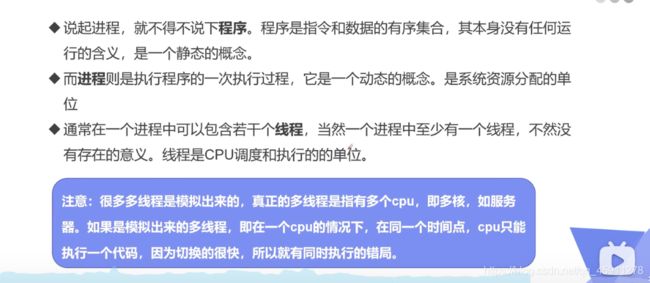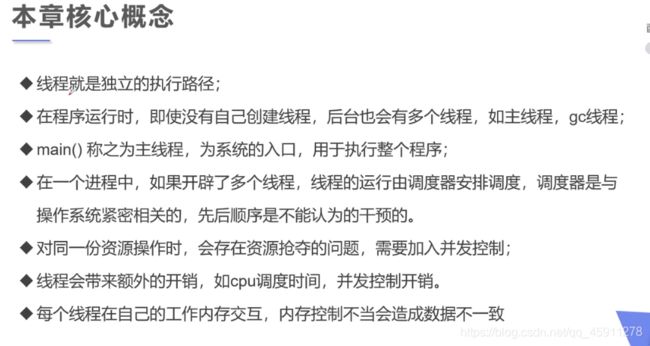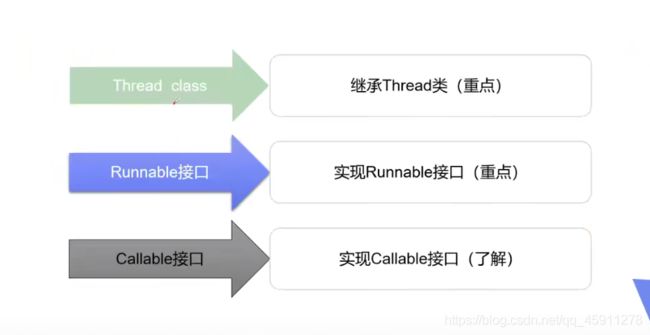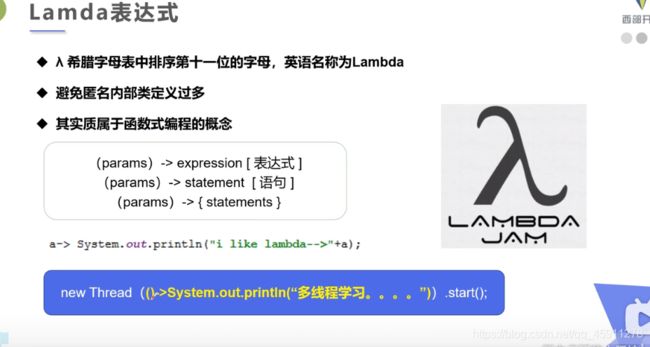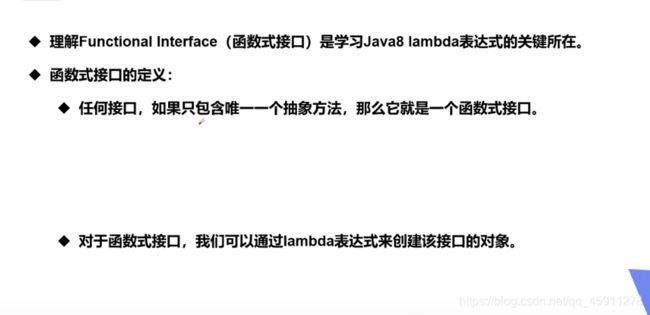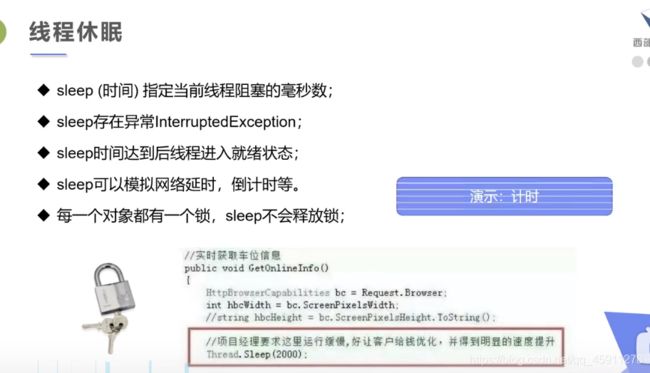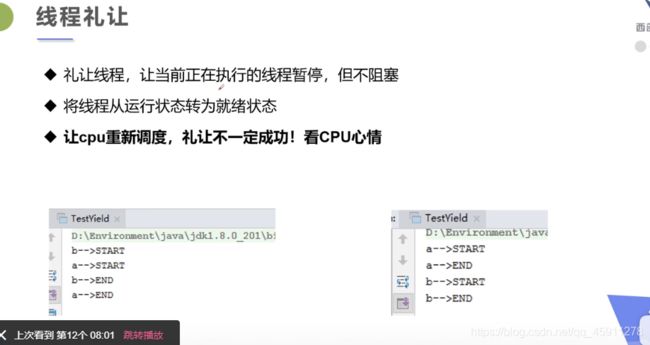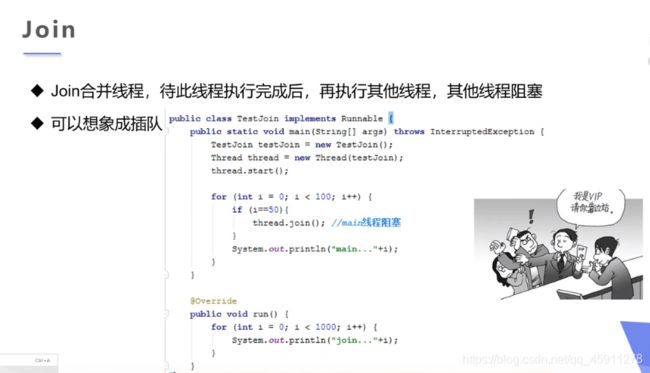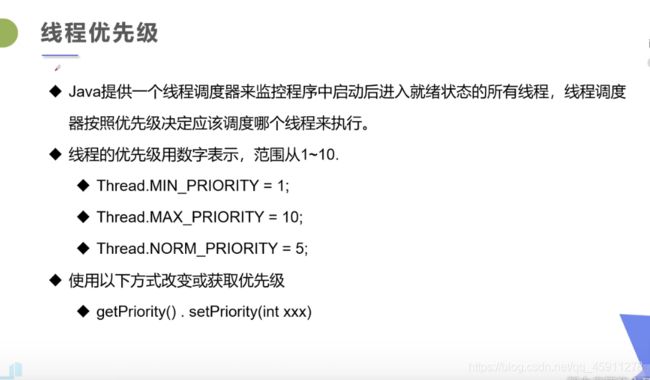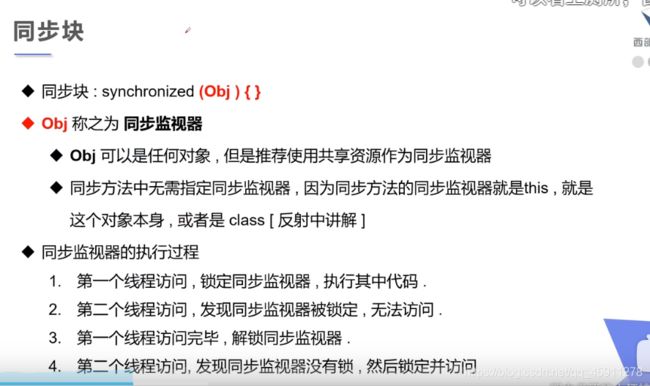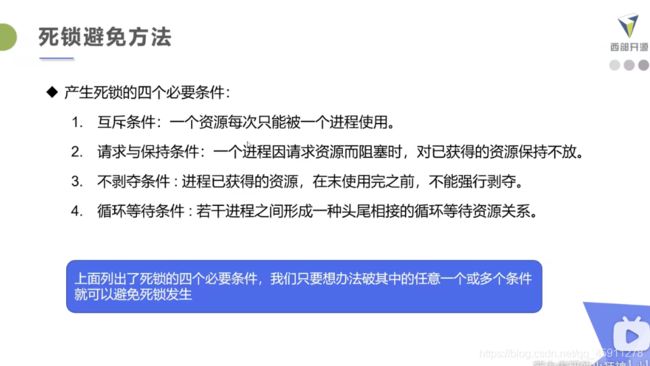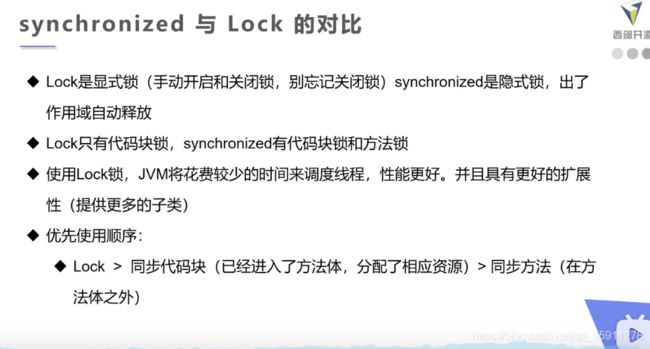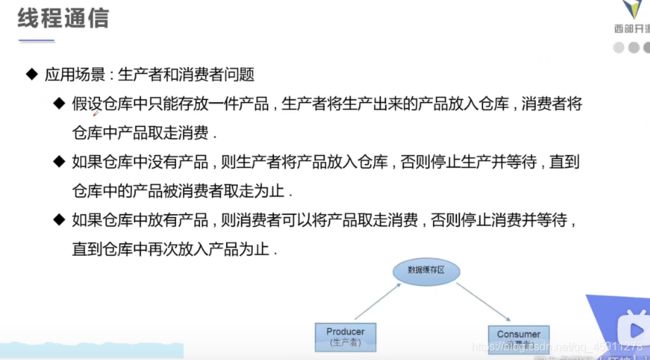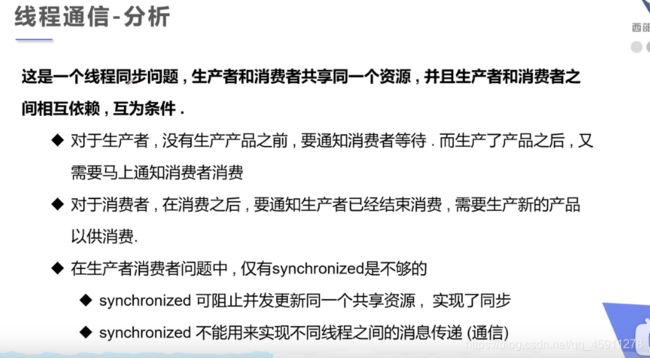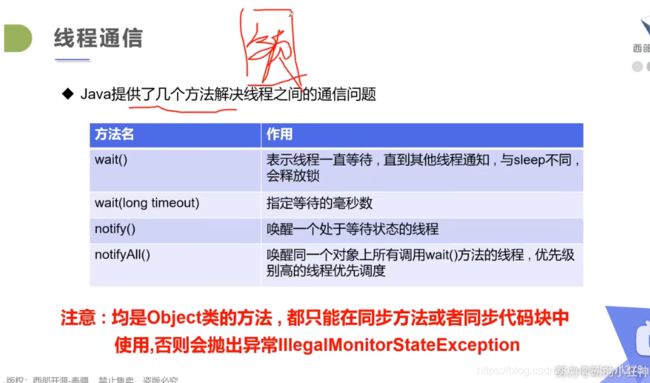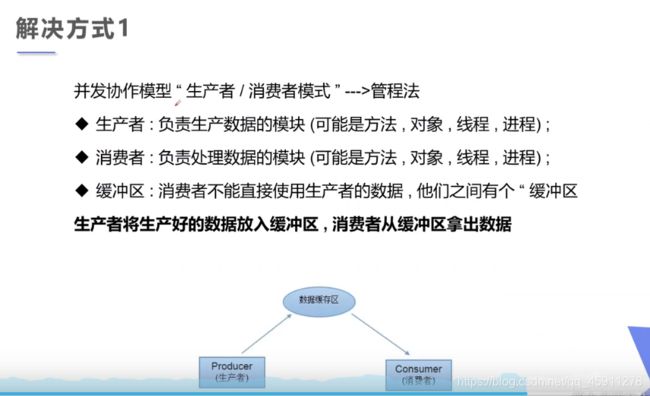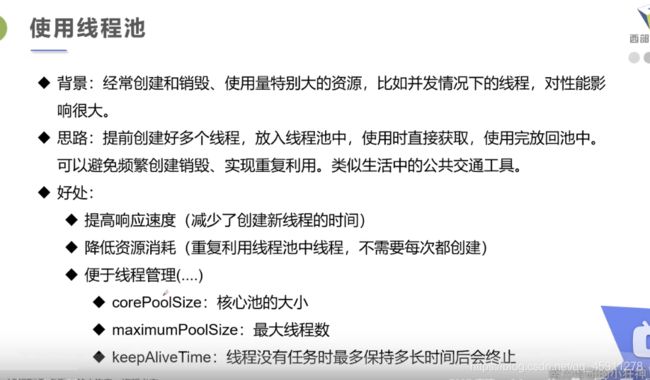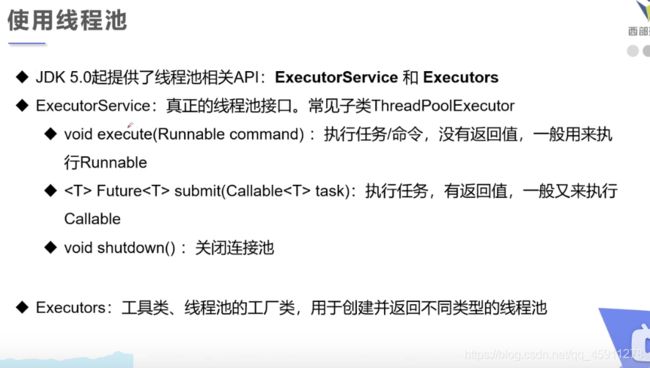Java多线程(入门系列)
狂神说笔记整理
一、线程简介与核心概念
二、线程创建
- Callable暂作了解,不是目前的重点
- 继承Thread类
package kssManyThread;
public class day1 extends Thread{
// 1.继承Thread类
// 2.重写run方法
@Override
public void run() {
for(int i = 0;i<20;i++)
System.out.println("我在看代码--"+i);
}
public static void main(String[] args) {
//创建一个线程对象
day1 day = new day1();
day.start();//如果这里是run, 则会先执行run方法
for(int i = 0;i<20;i++){
System.out.println("我在学习多线程--"+i);
}
}
}
- 继承Runnable接口
package kssManyThread;
public class day1 implements Runnable{
// 继承Runnable接口
//重写run方法 将执行线程丢入runnable接口实现
@Override
public void run() {
for(int i = 0;i<10;i++){
System.out.println("我在看代码--"+i);
}
}
public static void main(String[] args) {
//创建runnable接口实现对象
day1 day = new day1();
//创建线程对象, 通过线程对象来开启我们的线程
Thread thread = new Thread(day);
thread.start();
}
}
推荐使用第二种继承Runnable接口的方法,因为这样的话使用会更灵活,方便一个对象被多个线程使用
- 火车票案例
- 多个线程同时操作一个对象会不安全
package kssManyThread;
// 多个线程同时操作一个对象
// 买火车票的方法
// 发现多个线程操作同一个资源的情况下, 线程不安全
public class day1 implements Runnable{
//票数
private int ticksNums = 10;
@Override
public void run() {
while (true){
//模拟延时
try {
Thread.sleep(200);
} catch (InterruptedException e) {
e.printStackTrace();
}
System.out.println(Thread.currentThread().getName()+"拿到了"+ticksNums--+"票");
if (ticksNums<=0){
break;
}
}
}
public static void main(String[] args) {
day1 day = new day1();
new Thread(day, "小明").start();
new Thread(day, "老师").start();
new Thread(day, "黄牛").start();
}
}
- 模拟龟兔赛跑
package kssManyThread;
// 模拟龟兔赛跑
public class day1 implements Runnable{
//胜利者
private static String winner;
@Override
public void run() {
for(int i = 0;i<=100;i++){
// 模拟兔子休息
if (Thread.currentThread().getName().equals("兔子")&& i%10==0){
try {
Thread.sleep(1);
} catch (InterruptedException e) {
e.printStackTrace();
}
}
//判断比赛是否结束
boolean flag = gameOver(i);
if (flag){
//为真,就停止程序;
break;
}
System.out.println(Thread.currentThread().getName()+"跑了"+i+"步");
}
}
//判断是否完成比赛
private boolean gameOver(int steps){
//判断是否有胜率者
if (winner != null)
return true;
else if(steps>=100){
winner = Thread.currentThread().getName();
System.out.println("Winner is " + winner);
return true;
}else{
return false;
}
}
public static void main(String[] args) {
day1 day = new day1();
new Thread(day,"兔子").start();
new Thread(day,"乌龟").start();
}
}
- 静态代理模式
package kssManyThread;
// 静态代理模式: 真实对象跟代理对象都要实现同一个接口,代理对象要代理真实角色,就是要有一个参数把真实角色传进去
// 代理对象可以做很多真实对象做不了的事情
public class day1 {
public static void main(String[] args) {
//自己结婚
You you = new You();
you.HappyMarry();
new Thread( ()-> System.out.println("我爱你")).start();
//代理结婚
new WeddingCompany(new You()).HappyMarry();
//WeddingCompany weddingCompany = new WeddingCompany(new You());
//weddingCompany.HappyMarry();
}
}
interface Marry{
void HappyMarry();
}
// 真实角色, 你去结婚
class You implements Marry{
@Override
public void HappyMarry() {
System.out.println("结婚啦!!!,超开心");
}
}
// 代理角色, 帮助你结婚
class WeddingCompany implements Marry{
// 真实对象
private Marry target;
public WeddingCompany(Marry target){
this.target = target;
}
@Override
public void HappyMarry() {
before();
this.target.HappyMarry(); // 这就是真实对象
after();
}
private void after() {
System.out.println("结婚之后,布置收尾款");
}
private void before() {
System.out.println("结婚之前, 布置现场");
}
}
package kssManyThread;
public class day1 {
// 3.静态内部类
static class Like2 implements ILike{
@Override
public void lambda() {
System.out.println("i like lambda2");
}
}
public static void main(String[] args) {
ILike like = new Like();
like.lambda(); // 普通的类
like = new Like2();
like.lambda(); //静态内部类
// 4.局部内部类
class Like3 implements ILike{
@Override
public void lambda() {
System.out.println("i like lambda3");
}
}
like = new Like3(); // 局部内部类
like.lambda();
// 5.匿名内部类 ,没有类的名称, 必须借助接口或者父类
like = new ILike() {
@Override
public void lambda() {
System.out.println("i like lambda4");
}
};
like.lambda();
// lambda表达式再简化
like = ()->{
System.out.println("i like lambda5");
};
like.lambda();
}
}
// 1.实现一个函数式接口
interface ILike{
void lambda();
}
// 2.实现类
class Like implements ILike{
@Override
public void lambda() {
System.out.println("i like lambda");
}
}
- 带参数的lambda表达式
package kssManyThread;
public class day1 {
public static void main(String[] args) {
ILike like = (int a)->{
System.out.println("i like lambda"+a);
};
like.lambda(2);
}
}
// 1.实现一个函数式接口
interface ILike{
void lambda(int a);
}
// 2.实现类
class Like implements ILike{
@Override
public void lambda(int a) {
System.out.println("i like lambda"+a);
}
}
- lambda再简化
package kssManyThread;
public class day1 {
public static void main(String[] args) {
ILike like = null;
like = a-> System.out.println("i like lambda"+a);
like.lambda(2);
//进一步简化 可以没有int(参数类型),可以没有括号(),花括号也可以去掉
// 注意前提, 代码只有一行,花括号才能简化
//接口必须为函数式接口
// 多个参数可以去掉类型,要去掉都去掉,但括号要打上去
}
}
// 1.实现一个函数式接口
interface ILike{
void lambda(int a);
}
// 2.实现类
class Like implements ILike{
@Override
public void lambda(int a) {
System.out.println("i like lambda"+a);
}
}
三、线程状态
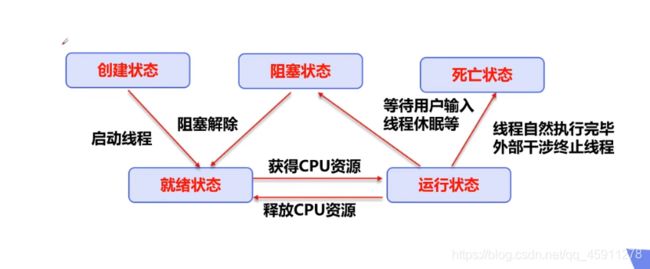
-------------------------------------------------------------------------------------------------------------------------------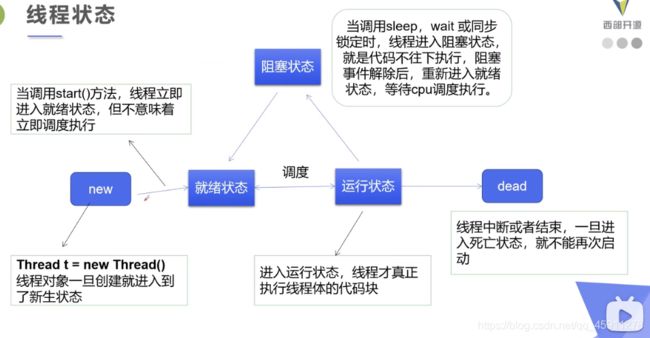


- 线程停止案例
package kssManyThread;
import java.util.Date;
// 1、建议线程正常停止,利用次数,不建议死循环
// 2、建议使用标志位
// 3、不要使用stop或destroy等JDK不建议使用的方法
public class day1 implements Runnable {
// 1.设置一个标志位
private boolean flag = true;
@Override
public void run() {
int i = 0;
while(flag){
System.out.println("run....Thread"+i++);
}
}
// 2.设置一个公开的方法停止线程
public void stop(){
this.flag = false;
}
public static void main(String[] args) {
day1 day = new day1();
new Thread(day).start();
for (int i = 0; i < 1000; i++) {
System.out.println("main"+i);
if (i==900){
//调用自己写的stop方法让线程停止
day.stop();
System.out.println("线程停止");
}
}
}
}
- 模拟倒计时
package kssManyThread;
// 模拟倒计时
public class day1{
public static void tenDown() throws InterruptedException {
int num = 10;
while(true){
Thread.sleep(1000);
System.out.println(num--);
if(num<=0){
break;
}
}
}
public static void main(String[] args) throws InterruptedException {
tenDown();
}
}
- 打印系统当前时间(前一秒)
package kssManyThread;
import java.text.SimpleDateFormat;
import java.util.Date;
// 打印系统当前时间
public class day1{
public static void tenDown() throws InterruptedException {
int num = 10;
Date startTime = new Date(System.currentTimeMillis());//获取系统当前时间
while (true){
Thread.sleep(1000);
System.out.println(new SimpleDateFormat("HH:mm:ss").format(startTime));
startTime = new Date(System.currentTimeMillis());//更新时间
}
}
public static void main(String[] args) throws InterruptedException {
tenDown();
}
}
- 案例
package kssManyThread;
// 测试礼让线程, 礼让不一定成功,看CPU心情
public class day1 {
public static void main(String[] args) throws InterruptedException {
MyYield myYield = new MyYield();
new Thread(myYield,"A").start();
new Thread(myYield,"B").start();
}
}
class MyYield implements Runnable{
@Override
public void run() {
System.out.println(Thread.currentThread().getName()+"线程开始执行");
Thread.yield();//礼让
System.out.println(Thread.currentThread().getName()+"线程停止执行");
}
}
package kssManyThread;
//测试join
public class day1 implements Runnable {
public static void main(String[] args) throws InterruptedException {
day1 day = new day1();
Thread thread = new Thread(day);
thread.start();
//主线程
for (int i = 0; i < 500; i++) {
if (i==200){
thread.join();//插队,即主线程让thread线程插队
}
System.out.println("mian"+i);
}
}
@Override
public void run() {
for (int i = 0; i < 1000; i++) {
System.out.println("线程vip来了");
}
}
}
- 观察测试线程的状态
package kssManyThread;
// 观察测试线程的状态
public class day1 {
public static void main(String[] args) throws InterruptedException {
Thread thread = new Thread(()->{
for (int i = 0; i < 5; i++) {
try {
Thread.sleep(1000);
} catch (InterruptedException e) {
e.printStackTrace();
}
}
System.out.println("");
});
//观察状态
Thread.State state = thread.getState();
System.out.println(state); //NEW
//观察启动后
thread.start();
state = thread.getState();
System.out.println(state); //Run
while (state != Thread.State.TERMINATED){
//只要线程一直不终止,就一直输出装填
Thread.sleep(100);
state = thread.getState();//更新线程状态
System.out.println(state);
}
}
}
四、线程优先级
- 案例
package kssManyThread;
// 线程优先级高并不一定先执行
public class day1 implements Runnable{
@Override
public void run() {
System.out.println(Thread.currentThread().getName()+"-->"+Thread.currentThread().getPriority());
}
public static void main(String[] args) {
//主线程默认优先级 5
System.out.println(Thread.currentThread().getName()+"-->"+Thread.currentThread().getPriority());
day1 day = new day1();
Thread thread1 = new Thread(day);
Thread thread2 = new Thread(day);
Thread thread3 = new Thread(day);
Thread thread4 = new Thread(day);
Thread thread5 = new Thread(day);
Thread thread6 = new Thread(day);
//先设置优先级再启动
thread1.start();
thread2.setPriority(1);
thread2.start();
thread3.setPriority(4);
thread3.start();
thread4.setPriority(Thread.MAX_PRIORITY);
thread4.start();
//thread5.setPriority(-1); 会报错,下面也是如此
//thread5.start();
//thread6.setPriority(11);
//thread6.start();
}
}
五、守护线程
package kssManyThread;
// 测试守护线程 上帝守护着你
public class day1 {
public static void main(String[] args) {
God god = new God();
You you = new You();
Thread thread = new Thread(god);
thread.setDaemon(true); // 默认false是用户线程,正常的线程都是用户线程
thread.start(); //守护线程启动
new Thread(you).start(); //用户线程启动
}
}
// 上帝
class God implements Runnable{
@Override
public void run() {
while (true){
System.out.println("上帝保佑你");
}
}
}
// 你
class You implements Runnable{
@Override
public void run() {
for (int i = 0; i < 36500; i++) {
System.out.println("活着");
}
System.out.println("goodbye world");
}
}
六、线程同步
package kssManyThread;
// 不安全的买票
public class day1 {
public static void main(String[] args) {
BuyTickets station = new BuyTickets();
new Thread(station,"苦逼的我").start();
new Thread(station,"牛逼的你").start();
new Thread(station,"可恶的黄牛党").start();
}
}
class BuyTickets implements Runnable{
boolean flag = true;//外部停止
//票
private int ticketNum = 10;
@Override
public void run() {
//买票
while (flag){
try {
buy();
} catch (InterruptedException e) {
e.printStackTrace();
}
}
}
private void buy() throws InterruptedException {
//模拟延时 放大问题的发生性
Thread.sleep(100);
//判断是否有票
if (ticketNum<=0) return;
else {
System.out.println(Thread.currentThread().getName()+"拿到"+ticketNum--);
}
}
}
package kssManyThread;
// 不安全的买盘
public class day1 {
public static void main(String[] args) {
BuyTickets station = new BuyTickets();
new Thread(station,"苦逼的我").start();
new Thread(station,"牛逼的你").start();
new Thread(station,"可恶的黄牛党").start();
}
}
class BuyTickets implements Runnable{
boolean flag = true;//外部停止
//票
private int ticketNum = 10;
@Override
public void run() {
//买票
while (flag){
try {
buy();
} catch (InterruptedException e) {
e.printStackTrace();
}
}
}
//同步方法 锁的是this 锁同步块也一样,只要传入要锁的对象就行了,即这个要锁的是要改变的东西
private synchronized void buy() throws InterruptedException {
//模拟延时 放大问题的发生性
Thread.sleep(100);
//判断是否有票
if (ticketNum<=0) {
flag = false;
return;
}
else {
System.out.println(Thread.currentThread().getName()+"拿到"+ticketNum--);
}
}
}
package kssManyThread;
// 死锁:多个线程互相抱着对方需要的资源,然后形成僵持
public class day1 {
public static void main(String[] args) {
Makeup g1 = new Makeup(0,"灰姑凉");
Makeup g2 = new Makeup(1,"白雪公主");
g1.start();
g2.start();
}
}
// 口红
class Lipstick{
}
//镜子
class Mirror{
}
class Makeup extends Thread {
// 需要的资源只有一份,用static来保证
static Lipstick lipstick = new Lipstick();
static Mirror mirror = new Mirror();
int choice; // 选择
String girlName;//使用化妆品的人
Makeup(int choice, String girlName) {
this.choice = choice;
this.girlName = girlName;
}
@Override
public void run() {
try {
makeup();
} catch (InterruptedException e) {
e.printStackTrace();
}
}
// 化妆,互相持有对方的锁,就是要拿到对方的资源
private void makeup() throws InterruptedException {
if (choice == 0) {
synchronized (lipstick) {
//获得口红锁
System.out.println(this.girlName + "获取口红的锁");
Thread.sleep(1000);
synchronized (mirror) {
System.out.println(this.girlName + "获得镜子的锁");
}
}
} else {
synchronized (mirror) {
System.out.println(this.girlName + "获取镜子的锁");
Thread.sleep(2000);
synchronized (lipstick) {
System.out.println(this.girlName + "获得口红的锁");
}
}
}
}
}
package kssManyThread;
import java.util.concurrent.locks.ReentrantLock;
// lock锁
public class day1 {
public static void main(String[] args) {
TestLock2 testLock2 = new TestLock2();
new Thread(testLock2).start();
new Thread(testLock2).start();
new Thread(testLock2).start();
}
}
class TestLock2 implements Runnable{
int tickets = 10;
//定义lock锁
private final ReentrantLock lock = new ReentrantLock();
@Override
public void run() {
while (true){
try{
lock.lock();//加锁
if (tickets>0){
try {
Thread.sleep(1000);
} catch (InterruptedException e) {
e.printStackTrace();
}
System.out.println(tickets--);
}else{
break;
}
}finally {
lock.unlock();//解锁
}
}
}
}
七、线程通信
- 管程法
package kssManyThread;
// 测试生产者消费者模型-->利用缓冲区解决:管程法
import java.awt.*;
public class day1 {
public static void main(String[] args) {
SynContainer container = new SynContainer();
new Productor(container).start();
new Consumer(container).start();
}
}
//生产者
class Productor extends Thread{
SynContainer container;
public Productor(SynContainer container){
this.container = container;
}
//生产
@Override
public void run() {
for (int i = 0; i < 100; i++) {
try {
container.push(new Chicken(i));
} catch (InterruptedException e) {
e.printStackTrace();
}
System.out.println("生产了第"+i+"只鸡");
}
}
}
//消费者
class Consumer extends Thread{
SynContainer container;
public Consumer(SynContainer container){
this.container = container;
}
//消费
@Override
public void run() {
for (int i = 0; i < 100; i++) {
try {
System.out.println("消费了第"+ container.pop().id+"只鸡");
} catch (InterruptedException e) {
e.printStackTrace();
}
}
}
}
//产品
class Chicken{
int id;//产品编号
public Chicken(int id){
this.id = id;
}
}
//缓冲区
class SynContainer{
//需要一个容器大小
Chicken[] chickens = new Chicken[10];
//容器计数器
int count = 0;
//生产者放入chanp
public synchronized void push(Chicken chicken) throws InterruptedException {
//如果容器满了,就要等待消费者消费
if (count== chickens.length){
//通知消费者消费,生产者等待
this.wait();
}
//如果没满,就要丢入产品
chickens[count] = chicken;
count++;
//可以通知消费者消费
this.notifyAll();
}
//消费者消费产品
public synchronized Chicken pop() throws InterruptedException {
//判断能否消费
if (count==0){
//等待生产者生产,消费者等待
this.wait();
}
//如果可以消费
count--;
Chicken chicken = chickens[count];
//吃完了,通知生产者生产
return chicken;
}
}
- 信号灯
package kssManyThread;
public class day1 {
public static void main(String[] args) {
TV tv = new TV();
new Player(tv).start();
new Watcher(tv).start();
}
}
// 生产者--演员
class Player extends Thread{
TV tv;
public Player(TV tv){
this.tv = tv;
}
@Override
public void run() {
for (int i = 0; i < 20; i++) {
if (i%2==0){
try {
this.tv.play("快乐大本营播放ing");
} catch (InterruptedException e) {
e.printStackTrace();
}
}else{
try {
this.tv.play("抖音,记录美好生活");
} catch (InterruptedException e) {
e.printStackTrace();
}
}
}
}
}
//消费者--观众
class Watcher extends Thread{
TV tv;
public Watcher(TV tv){
this.tv = tv;
}
@Override
public void run() {
for (int i = 0; i < 20; i++) {
try {
tv.Watch();
} catch (InterruptedException e) {
e.printStackTrace();
}
}
}
}
//产品 --节目
class TV{
//演员表演,观众等待 T
//观众观看,演员等待 F
String voice;//表演的节目
boolean flag = true;
//表演
public synchronized void play(String voice) throws InterruptedException {
if (!flag){
//演员等待
this.wait();
}
System.out.println("演员表演了:"+voice);
//通知观众观看
this.notifyAll();//唤醒
this.voice = voice;
this.flag = !this.flag;
}
//观看
public synchronized void Watch() throws InterruptedException {
if (flag){
this.wait();
}
System.out.println("观看了:"+voice);
// 通知演员表演
this.notifyAll();
this.flag = !this.flag;
}
}
八、线程池
package kssManyThread;
import java.util.concurrent.ExecutorService;
import java.util.concurrent.Executors;
//线程池
public class day1 {
public static void main(String[] args) {
// 1.创建线程池
ExecutorService service = Executors.newFixedThreadPool(10);//参数为线程池大小
// 执行
service.execute(new MyThead());
service.execute(new MyThead());
service.execute(new MyThead());
service.execute(new MyThead());
//2.关闭连接
service.shutdown();
}
}
class MyThead implements Runnable{
@Override
public void run() {
System.out.println(Thread.currentThread().getName());
}
}
